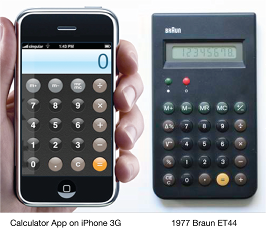Skeuomorph is an interesting word.
It’s from the Greek for vessel/tool (skeuos) and shape (morphe) and is basically used to describe something which retains the design cues from an original product, even when these aren’t necessary anymore. Examples would include digital music players which have the look and feel of a real-world device like a car radio or online calendars that present information in the style of a paper, month by month calendar.
In many ways, a Skeuomorph is positive as it allows us to transition from the old to the new; letting people understand how something works as it replicates the look and feel of the original. The example below shows how the iphone calculator look and feel is based heavily on the extremely popular 1977 Braun ET44 calculator, even down to the button colouring.

However, skeuomorphs can also hold our thinking back. Rather than trying to re-think a problem with newly available technology, it is sometimes easier to try and transfer the existing solution into a new medium.
Digital advertising for example simply tried to transfer the understanding and heritage of the physical world into the digital. The direct mail campaign morphed into the email campaign and the outdoor poster into the banner ad. It took a different kind of thinking from a young upstart called Google to approach it in another way back in 2000. Google did away with the visual aspects and instead focused on the relevancy, linking text based adverts to search terms. Combined with their innovation around ranking/click-thrus, this helped propel Google to the number 1 position.
Google hasn’t done too well in another domain however – namely digital wallets. When people talk about digital wallets, they discuss taking your existing payment cards, loyalty cards and paper coupons and essentially digitising these into a smart phone application. Indeed, the Google Wallet even shows a representation of a credit card so you can choose how to pay.

The problem with this though is it’s trying to solve a problem people don’t have and doing it by simply moving what people have and do today into another medium. In reality, you are simply exchanging a leather folder for a smart phone – it’s skeuomorphic design. What it’s not really doing is challenging how people pay.
Of course, I’m not a payments expert, so I’ll leave it to someone who is, namely Jack Stephenson, Director of Mobile, E-Commerce and Payments at JP Morgan Chase who said:-
“Consumers don’t really have a mobile payment problem. Ninety-five percent of the time, paying with cash and credit cards actually works pretty well. Consumers have a mobile shopping problem. There’s a difference.”
While I agree with the first part of Jack’s observation, I don’t really agree with the latter. Consumers don’t have a mobile shopping problem either, they have a money management problem – and many of them don’t even realise it.
As I’ve discussed in a previous blog, if we’re going to change how consumers pay, we should take the opportunity to change how consumer think about payments. Instead of being bounded by a skeuomorphic requirement to replicate the old, we should look to invent the new.
And that’s just what PayPal have done.
Paypal are looking to reinvent our relationship with money. Not just our physical money or payment cards, but all of our liquid assests, from loyalty points to gift cards. If it can be converted into cash, PayPal will let you use it.
To support this they have separated the decision to purchase from the method of purchase. After buying through PayPal you then have 7 days to indicate how you’d like to pay for the item and this could be from a combination of:-
- Money you’ve saved for it such as a travel savings
- Money you have on a retailers gift card
- Money you have in loyalty points from a frequent flyer
- Money you have in your checking/current account
- Money you have access to from your credit card
- Money you don’t have access to yet – so it lets you spread the cost over 3 equal payments
Any and all of these types of funds can be used to pay for the transaction. Now you can save for something and then literally pay for it from your savings.
It’s worth watching the following videos from Finextra to see how really revolutionary this is.
Skeuomorphs can help us to transition people from the old to the new, but holding onto the old can also limit our ability to truly transform how we do business.
For loyalty, the collecting of points hasn’t really changed fundamentally since the original paper stamps back in the 1930′. Even Google startup Punchd is simply transferring the paper punchcard to a smart phone medium.
Maybe it’s time to rethink loyalty recognition for a new era. #gamification



